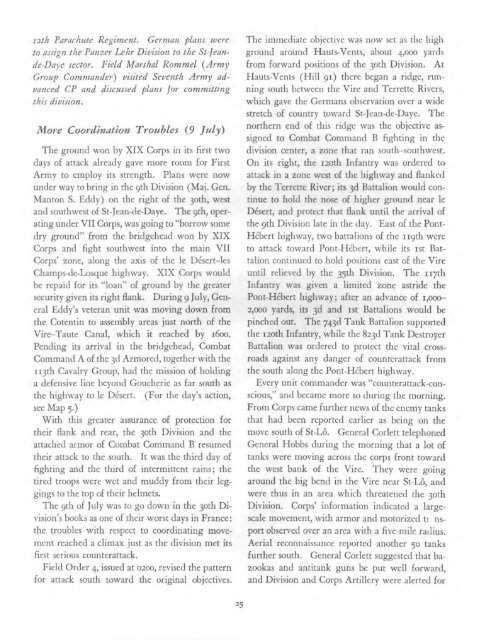To download as PDF click here - US Army Center Of Military History
To download as PDF click here - US Army Center Of Military History
To download as PDF click here - US Army Center Of Military History
You also want an ePaper? Increase the reach of your titles
YUMPU automatically turns print PDFs into web optimized ePapers that Google loves.
12th Paracl!t/te Regime1lt. Germall plalls were<br />
to <strong>as</strong>sign the Pallzer Lehr Divisioll to the St-lea1lde-Daye<br />
sector. Field Marshal Rommel (<strong>Army</strong><br />
Group Comma1lder) visited Seve1lth <strong>Army</strong> advanced<br />
CP alld discussed plans for committil1g<br />
this divisio1l .<br />
More Coordination Troubles (9 July)<br />
The ground won by XIX Corps in its first two<br />
days of attack already gave more room for First<br />
<strong>Army</strong> to employ its strength. Plans were now<br />
under way to bring in the 9th Division (Maj. Gen.<br />
Manton S. Eddy) on the right of the 30th, west<br />
and southwest of St-Jean-de-Daye. The 9th, operating<br />
under VII Corps, w<strong>as</strong> going to "borrow some<br />
dry ground" from the bridgehead won by XIX<br />
Corps and fight southwest into the main VII<br />
Corps' zone, along the axis of the Ie Desert-les<br />
Champs-de-Losque highway. XIX Corps would<br />
be repaid for its "loan" of ground by the greater<br />
security given its right flank. During 9 July, General<br />
Eddy's veteran unit w<strong>as</strong> moving down from<br />
the Cotentin to <strong>as</strong>sembly are<strong>as</strong> just north of the<br />
Vire-Taute Canal, which it reached by 1600.<br />
Pending its arrival in the bridgehead, Combat<br />
Command A of the 3d Armored, together with the<br />
Il3th Cavalry Group, had the mission of holding<br />
a defensive line beyond Goucherie <strong>as</strong> far south <strong>as</strong><br />
the highway to Ie Desert. (For the day's action,<br />
see Map 5.)<br />
With this greater <strong>as</strong>surance of protection for<br />
their flank and rear, the 30th Division and the<br />
attached armor of Combat Command B resumed<br />
their attack to the south. It w<strong>as</strong> the third day of<br />
fighting and the third of intermittent rains; the<br />
tired troops were wet and muddy from their leggings<br />
to the top of their helmets.<br />
The 9th of July w<strong>as</strong> to go down in the 30th Division's<br />
books <strong>as</strong> one of their worst days in France:<br />
the troubles with respect to coordinating movement<br />
reached a climax just <strong>as</strong> the division met its<br />
first serious counterattack.<br />
Field Order 4, issued at 0200, revised the pattern<br />
for attack south toward the original objectives.<br />
25<br />
The immediate objective w<strong>as</strong> now set <strong>as</strong> the high<br />
ground around Hauts-Vents, about 4,000 yards<br />
from forward positions of the 30th Division. At<br />
Hauts-Vents (Hill 91) t<strong>here</strong> began a ridge, running<br />
south between the Vire and Terrette Rivers,<br />
which gave the Germans observation over a wide<br />
stretch of country toward St-Jean-de-Daye. The<br />
northern end of this ridge w<strong>as</strong> the objective <strong>as</strong>signed<br />
to Combat Command B fighting in the<br />
division center, a zone that ran south-southwest.<br />
On its right, the 120th Infantry w<strong>as</strong> ordered to<br />
attack in a zone west of the highway and flanked<br />
by the Terrette River; its 3d Battalion would continue<br />
to hold the nose of higher ground near Ie<br />
Desert, and protect that flank wltil the arrival of<br />
the 9th Division late in the day. E<strong>as</strong>t of the Pont<br />
Hebert highway, two battalions of the II9th were<br />
to attack toward Pont-Hebert, while its 1st Battalion<br />
continued to hold positions e<strong>as</strong>t of the Vire<br />
until relieved by the 35th Division. The Il7th<br />
Infantry w<strong>as</strong> given a limited zone <strong>as</strong>tride the<br />
Pont-Hebert highway; after an advance of 1,000-<br />
2,000 yards, its 3d and 1st Battal ions would be<br />
pinched out. The 743d Tank Battalion supported<br />
the 120th Infantry, while the 823d Tank Destroyer<br />
Battalion w<strong>as</strong> ordered to protect the vital crossroads<br />
against any danger of counterattack from<br />
the south along the Pont-Hebert high way.<br />
Every unit commander w<strong>as</strong> "counterattack-conscious,"<br />
and became more so during the morning.<br />
From Corps came further news of the enemy tanks<br />
that had been reported earlier <strong>as</strong> being on the<br />
move south of St-LB. General Corlett telephoned<br />
General Hobbs during the morning that a lot of<br />
tanks were moving across the corps front toward<br />
the west bank of the Vireo They were going<br />
around the big bend in the Vire near St-LB, and<br />
were thus in an area which threatened the 30th<br />
Division. Corps' information indicated a largescale<br />
movement, with armor and motorized tJ nsport<br />
observed over an area with a five-mile radius.<br />
Aerial reconnaissance reported another 50 tanks<br />
further south. General Corlett suggested that bazook<strong>as</strong><br />
and antitank guns be put well forward,<br />
and Division and Corps Artillery were alerted for
















